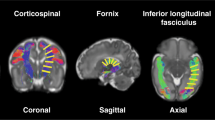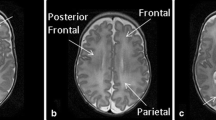Abstract
Background
White matter maturation is characterised by increasing fractional anisotropy (FA) and decreasing mean diffusivity (MD). Contradictory results have been published on the effect of premature birth on white matter maturation at term-equivalent age.
Objective
To assess the association of gestational age and low birth-weight-for-gestational-age (z-score) with white matter maturation.
Materials and methods
Infants (n = 76, 53 males) born at different gestational ages were imaged at term-equivalent age. Gestational age and birth weight z-score were used as continuous variables and the effect on diffusion parameters was assessed. Brain maturation was studied using regions-of-interest analysis in several white matter areas.
Results
Gestational age showed no significant effect on white matter maturation at term-equivalent age. Children with low birth weight z-score had lower FA in the genu and splenium of the corpus callosum (regression, P = 0.012 and P = 0.032; correlation, P = 0.009 and P = 0.006, respectively), and higher MD in the splenium of the corpus callosum (regression, P = 0.002; correlation, P = 0.0004) compared to children whose birth weight was appropriate for gestational age.
Conclusion
Children with low birth weight relative to gestational age show delay and/or anomaly in white matter maturation at term-equivalent age.


Similar content being viewed by others
References
Berman JI, Mukherjee P, Partridge SC et al (2005) Quantitative diffusion tensor MRI fiber tractography of sensorimotor white matter development in premature infants. Neuroimage 27:862–871
Provenzale JM, Liang L, DeLong D et al (2007) Diffusion tensor imaging assessment of brain white matter maturation during the first postnatal year. AJR 189:476–486
Pierpaoli C, Jezzard P, Basser PJ et al (1996) Diffusion tensor MR imaging of the human brain. Radiology 201:637–648
Saksena S, Husain N, Malik GK et al (2008) Comparative evaluation of the cerebral and cerebellar white matter development in pediatric age group using quantitative diffusion tensor imaging. Cerebellum 7:392–400
Arzoumanian Y, Mirmiran M, Barnes PD et al (2003) Diffusion tensor brain imaging findings at term-equivalent age may predict neurologic abnormalities in low birth weight preterm infants. AJNR 24:1646–1653
Krishnan ML, Dyet LE, Boardman JP et al (2007) Relationship between white matter apparent diffusion coefficients in preterm infants at term-equivalent age and developmental outcome at 2 years. Pediatrics 120:E604–E609
Kostovic I, Judas M (2010) The development of the subplate and thalamocortical connections in the human foetal brain. Acta Paediatr 99:1119–1127
Ramenghi LA, Martinelli A, De Carli A et al (2011) Cerebral maturation in IUGR and appropriate for gestational age preterm babies. Reprod Sci 18:469–475
Gimenez M, Miranda MJ, Born AP et al (2008) Accelerated cerebral white matter development in preterm infants: a voxel-based morphometry study with diffusion tensor MR imaging. NeuroImage 41:728–734
Huppi PS, Maier SE, Peled S et al (1998) Microstructural development of human newborn cerebral white matter assessed in vivo by diffusion tensor magnetic resonance imaging. Pediatr Res 44:584–590
Rose SE, Hatziaeorgiou X, Strudwick MW et al (2008) Altered white matter diffusion anisotropy in normal and preterm infants at term-equivalent age. Magn Reson Med 60:761–767
Drobyshevsky A, Bregman J, Storey P et al (2007) Serial diffusion tensor imaging detects white matter changes that correlate with motor outcome in premature infants. Dev Neurosci 29:289–301
Miller SP, Vigneron DB, Henry RG et al (2002) Serial quantitative diffusion tensor MRI of the premature brain: development in newborns with and without injury. J Magn Reson Imaging 16:621–632
Berman JI, Glass HC, Miller SP et al (2009) Quantitative fiber tracking analysis of the optic radiation correlated with visual performance in premature newborns. Am J Neuroradiol 30:120–124
Partridge SC, Mukherjee P, Henry RG et al (2004) Diffusion tensor imaging: serial quantitation of white matter tract maturity in premature newborns. NeuroImage 22:1302–1314
Counsell SJ, Shen YJ, Boardman JP et al (2006) Axial and radial diffusivity in preterm infants who have diffuse white matter changes on magnetic resonance imaging at term-equivalent age. Pediatrics 117:376–386
Hasegawa T, Yamada K, Morimoto M et al (2011) Development of corpus callosum in preterm infants is affected by the prematurity: in vivo assessment of diffusion tensor imaging at term-equivalent age. Pediatr Res 69:249–254
Thompson DK, Inder TE, Faggian N et al (2011) Characterization of the corpus callosum in very preterm and full-term infants utilizing MRI. Neuroimage 55:479–490
Lepomaki VK, Paavilainen TP, Hurme SA et al (2011) Fractional anisotropy and mean diffusivity parameters of the brain white matter tracts in preterm infants: reproducibility of region-of-interest measurements. Pediatr Radiol. doi:10.1007/s00247-011-2234-9
Bonifacio SL, Glass HC, Chau V et al (2010) Extreme premature birth is not associated with impaired development of brain microstructure. J Pediatr 157:726–732
Sanz-Cortes M, Figueras F, Bargallo N et al (2010) Abnormal brain microstructure and metabolism in small-for-gestational-age term fetuses with normal umbilical artery Doppler. Ultrasound Obstet Gynecol 36:159–165
Eixarch E, Meler E, Iraola A et al (2008) Neurodevelopmental outcome in 2-year-old infants who were small-for-gestational age term fetuses with cerebral blood flow redistribution. Ultrasound Obstet Gynecol 32:894–899
Figueras F, Eixarch E, Gratacos E et al (2008) Predictiveness of antenatal umbilical artery Doppler for adverse pregnancy outcome in small-for-gestational-age babies according to customised birthweight centiles: population-based study. BJOG 115:590–594
Leitner Y, Fattal-Valevski A, Geva R et al (2007) Neurodevelopmental outcome of children with intrauterine growth retardation: a longitudinal, 10-year prospective study. J Child Neurol 22:580–587
Lind A, Korkman M, Lehtonen L et al (2011) Cognitive and neuropsychological outcomes at 5 years of age in preterm children born in the 2000s. Dev Med Child Neurol 53:256–262
van Wassenaer A (2005) Neurodevelopmental consequences of being born SGA. Pediatr Endocrinol Rev 2:372–377
Szabo N, Gergev G, Kobor J et al (2011) Corpus callosum anomalies: birth prevalence and clinical spectrum in hungary. Pediatr Neurol 44:420–426
Pryor J (1997) The identification and long term effects of fetal growth restriction. Br J Obstet Gynaecol 104:1116–1122
Tolcos M, Bateman E, O'Dowd R et al (2011) Intrauterine growth restriction affects the maturation of myelin. Exp Neurol 232:53–65
Author information
Authors and Affiliations
Consortia
Corresponding author
Rights and permissions
About this article
Cite this article
Lepomäki, V., Paavilainen, T., Matomäki, J. et al. Effect of antenatal growth and prematurity on brain white matter: diffusion tensor study. Pediatr Radiol 42, 692–698 (2012). https://doi.org/10.1007/s00247-012-2352-z
Received:
Revised:
Accepted:
Published:
Issue Date:
DOI: https://doi.org/10.1007/s00247-012-2352-z




